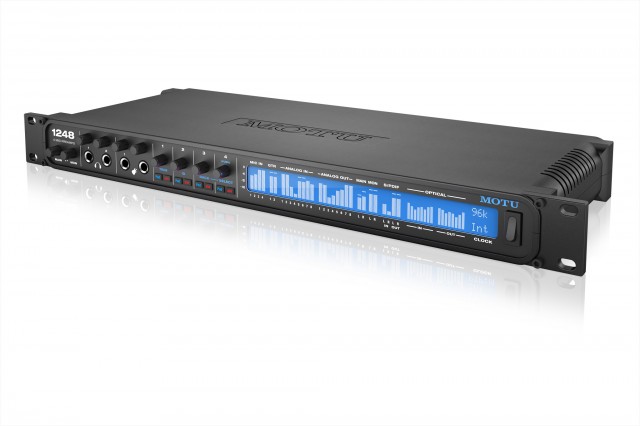You’d be forgiven for missing it in the blur of press releases and trade show hand-outs – and, let’s face it, most musicians are too focused on music to pay much mind. But slowly, steadily, audio interfaces have been getting a lot better. Talk to the people who make them, and they can tell you what’s happened even in terms of individual components.
Next, they’re about to get smarter and more networked.
And so that means it is worth paying attention today as industry heavyweight MOTU unveils a trio of new audio interfaces, compatible with Thunderbolt 1 and 2 and USB2. MOTU says all three are built on an all-new platform. What you get is three different I/O configurations, but all sharing the same headline features. In short, that includes:
- Thunderbolt connectivity plus USB 2.0
- 48-channel mixing and DSP built-in
- High-dynamic range analog/digital conversion (and d/a)
- Networking via the new AVB Ethernet standard for expansion with extremely-low latency
- Web-based control of the mixer, via any connection (wired or wireless)
Yes, you read that right – Web browser mixer control. So that mixer can be on iOS, on Android, on a computer, anything. (And with class-compliant USB, in fact, this whole box can work without ever seeing a driver or particular OS.)
A/D and D/A are the bit that impact the sound, but that networking is some interesting new sauce. AVB boasts both the ability to wire institutions with multiple audio interfaces in different rooms with next-to-null latency. Then, Web app support means you can let your guitarist tweak her headphone mix with her iPad. More on that in a bit.
Interfacing Features
The models: 1248, 8M, 16A. The 1248 is probably what readers here are most interested in: 8×2 balanced TRS analog I/O, four mic ins, two front-panel hi-Z inputs for guitars, two independent headphone outs, S/PDIF digital I/O. The 8M is if you want more inputs (eight analog outs, eight combo mic-line-instrument ins), whereas the 16A is all analog (16 ins, 16 outs, TRS).
As is the tradition with MOTU and a handful of rival vendors, these aren’t just “studio” interfaces, spec’ed only for sound engineers. They’re also configured in ways musicians might use in their own work. And, of course, they’re MOTU boxes, so you still get get not only all these mixing features, but standard functionality like word clock I/O (key for video production and the like).
Also interesting: that’s class-compliant USB, so you could theoretically connect these to an iPad if you wanted.
The analog-to-digital and digital-to-analog conversion is handled by ESS Sabre32 Ultras, which MOTU says mean that, on those TRS analog outs, you get some serious dynamic range – “a measured dynamic range of 123 dB (A-weighted, 20 Hz to 20 kHz).” And analog I/O latency has a round-trip of 32 samples (0.66 ms) at 48 kHz. (Note that doesn’t figure in the computer side of the equation, of course.)
And, they’re mixers, with internal DSPs, so you can add modeled analog EQs, compression, and gating in the box without adding latency on the computer.
So, that much is familiar. Here’s where things get interesting.
Networked Audio
What’s new is the Ethernet port with support for IEEE’s “802.1 Audio Video Bridging (AVB) extension to the Ethernet standard.”
Say what?
AVB is about the ability to combine interfaces via standard Ethernet cabling. You can even get a MOTU switch and connect three to five (or two using the onboard port).
Why is that interesting, apart from MOTU selling you more hardware? Well, you can not only daisy-chain interfaces, but do so over long runs – up to 100m between devices. And you can do that even over Ethernet cabling you already have. Once you do, you get up to 128 channels of networked audio with latency of 30 samples – just above half a millisecond – and then you can clock them.
Nerds, there’s open source AVB code from Intel:
https://github.com/AVnu/Open-AVB
plus reference implementations by xcore
Browser Mixer UI
You can also use the MOTU interfaces’ network savvy to control the mixer over the Web. The audio interface itself incorporates its own Web server, accessed via a connected machine on Thunderbolt or USB, or over that Ethernet port, or (with the Ethernet port jacked into a WiFi router), wirelessly.
Pricing isn’t astronomical, either. Each unit is US$1495.
More at MOTU:
Introducing the 1248, 8M and 16A



